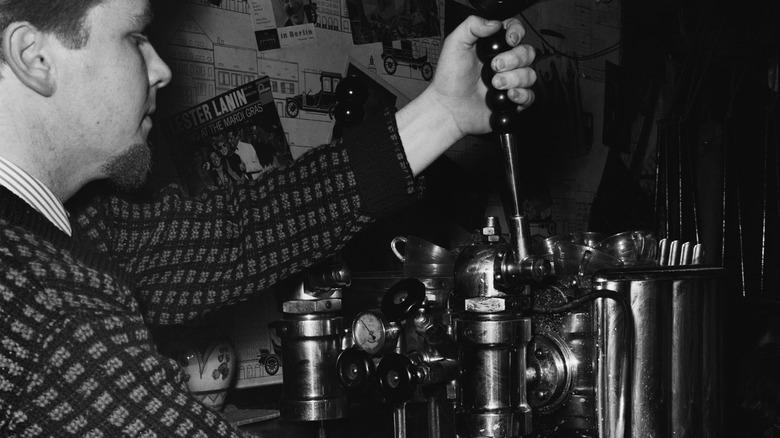How Italy's Industrial Revolution Helped Create The First Espresso
Espresso is a cornerstone of Italian culture. The bold, buzz-inducing coffee drink was invented in Italy and quickly became a staple — on average, Italy serves a staggering 14 billion espressos every year (via Coffee Research). The Italian word espresso translates to "pressed out" in English, referring to how the coffee is percolated with force through a machine's high-pressure chambers, making it a convenient and quick energy boost for Italians on the go.
Though a quintessential daily supplement to the people of Italy, espresso only recently came into existence in the 20th century. Like most other components of our contemporary world, its ubiquity today can be traced to the Industrial Revolution. This era of productivity helped transform Italy into the country that we have come to know — the Italy that brims with innovation as much as history. Espresso is a result of this innovation and continues to fuel it today.
Italy, industrialization, and espresso
The Industrial Revolution was a phenomenon that started in England in the 1700s and subsequently spread to other parts of the world. Italy's own industrial revolution played out between the late 1800s and early 1900s. Though it brought about many significant changes, the introduction of espresso may be one of the most palpable.
Between the production of hydroelectricity from the Alps and the inception of the Fiat automobile, industrialization meant speeding up the lifestyle of Italy. Italians had been enjoying coffee since the 1600s, and coffee shops were known to be a comfortable social atmosphere for Italians from all walks of life. Many inventors, including Angelo Moriondo, recognized a need for a coffee production method that would match the pace of life that was picking up.
The Industrial Revolution was catalyzed by the invention of the steam engine, so naturally, the original espresso machine was too. In 1884, Moriondo patented a "new steam machinery for the economic and instantaneous confection of coffee beverage," per Smithsonian Magazine.
Soon after, inventor team Luigi Bezzerra and Desiderio Pavoni improved on Moriondo's designs to create the first espresso machine to resemble the machines used today, pumping out single-serve shots with a portafilter and brewheads. Once they introduced their caffé espresso to the public at the 1906 Milan Fair, Italian coffee culture changed forever. More espresso machine-engineering successors worked to improve upon the design to cultivate consistent espresso shots. Most notably, Francesco Illy and Achille Gaggia's designs used more highly pressurized water and controlled the release of steam to reduce the burnt flavor. Gaggia invented a high-pressure lever machine after World War II that produced crema, the signature foamy layer on top of an espresso shot, which created the classic espresso as we know it today. In the 60s, inventor Ernesto Valente revolutionized the espresso world once again when he debuted a new machine that used motorized pumps to create the espresso, rather than relying on the manpower of the barista (via Smithsonian Magazine).
An ongoing era of espresso
Espresso machines have become much more efficient than their early 1900s ancestors, and with the readily available hits of caffeine they offer comes more demand. Most Italians drink coffee two to three times per day (per Statista), and it's not uncommon to hear of Italians who drink up to seven or eight espressos a day (via Lonely Planet).
While coffee was not born in Italy (historians have actually traced its origins to Ethiopia), it is Italy we have to thank for lattes, cappuccinos, and every smooth espresso-based drink the world has come to love. And even though espresso machines can be found throughout the world, the coffee culture of Italy has mostly remained in the country. Italians stay true to their coffee-drinking rituals, like drinking espresso with mineral water. A coffee "to-go" is not a part of the Italian lexicon. Most Italians will order their drink at a bar counter and finish it at the same counter. Like espresso powder in a portafilter, you would be hard-pressed to find a Dunkin' Donuts in Italy. Starbucks only appeared on the European peninsula in 2023, and offers unique Italian-style drinks on the menu.
The Industrial Revolution brought about changes for better or for worse. With its integrity to life in Italy and throughout the world, many would agree that the invention of espresso was a change for the better.


